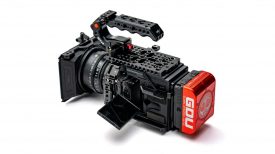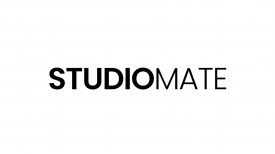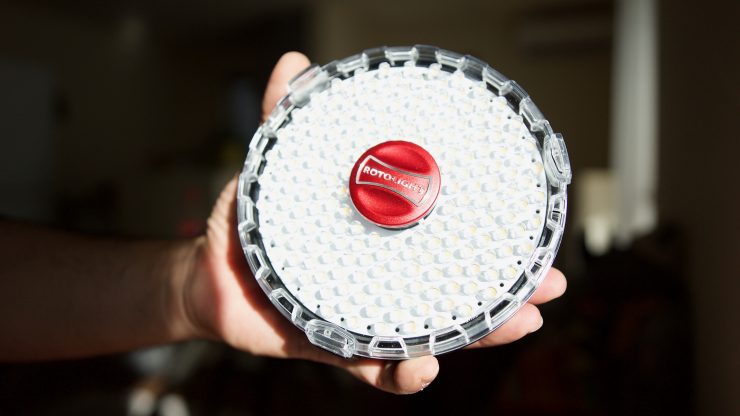
Sometimes the sequel fails to live up to the original, so how does Rotolight’s new NEO 2 stack up against its predecessor? On paper the NEO 2 looks to be a significant improvement over the original NEO. So what’s new? Well lets find out.
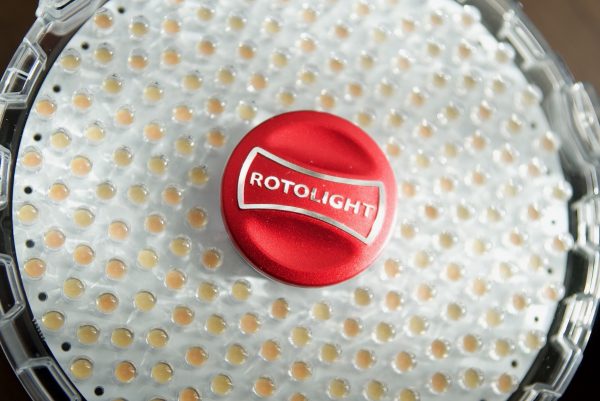
As the old saying goes, if it ain’t broke, don’t fix it. When I reviewed the NEO back in 2015 I found it to be a compact, versatile on-camera, bi-color LED light with a low power draw with good colour rendering. Rotolight have stuck with that formula, and just like the original, the NEO 2 is colour adjustable between 3150 to 6300K with a 50-degree beam angle. The biggest downside for me about the original NEO was its power, or more precisely, lack of. The Neo (when set at 5600K) only outputted 567lx at a distance of 1m (3.28ft). While this was more than most on-camera lights output, it wasn’t enough for me to consider using one as a key light for an interview.
Looks can be deceiving
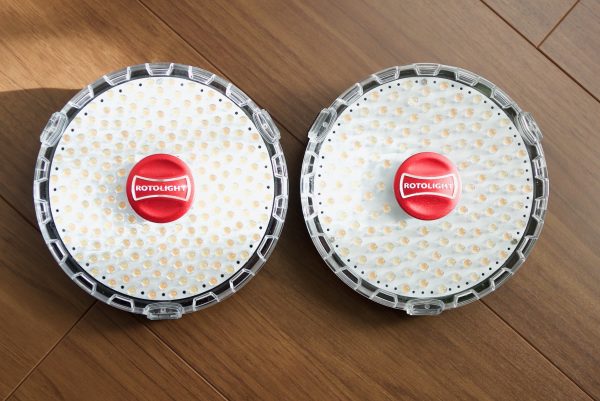
On the surface it’s hard to tell the NEO 2 apart from the original NEO. Rotolight haven’t changed the design of the NEO 2 much at all, most of the improvements can be found in the chassis. On the outside of the fixture Rotolight have recessed the on/of power button so it can’t be accidentally knocked while in transit and you turn up with dead batteries. There are also a few more heat dispersal vents than on the original. It can still be run off AA batteries, mains power or a camera battery, and it still incorporates True Aperture Dimming, Designer Fade Mode, and the SFX cinematic special effects.
If all these features weren’t enough, Rotolight has now incorporated the same HSS flash functionality that can be found in their larger Anova Pro and AEOS panel lights, as well as expanding on the SFX features to include gunshot, paparazzi, and neon flickering light.
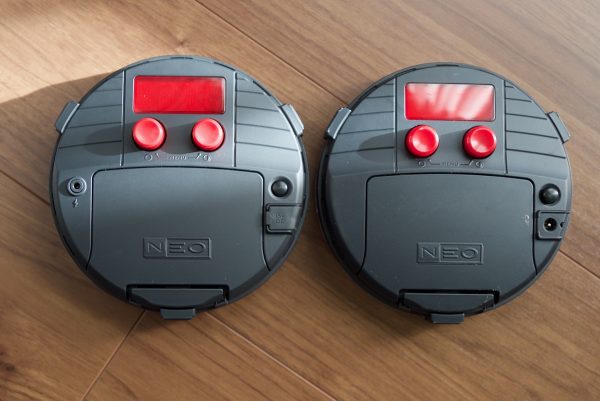
One of the physical differences is the addition of a Flash Sync port that can found on the left side. The controls remain the same and the menu system works in exactly the same way as the original NEO.
Build quality
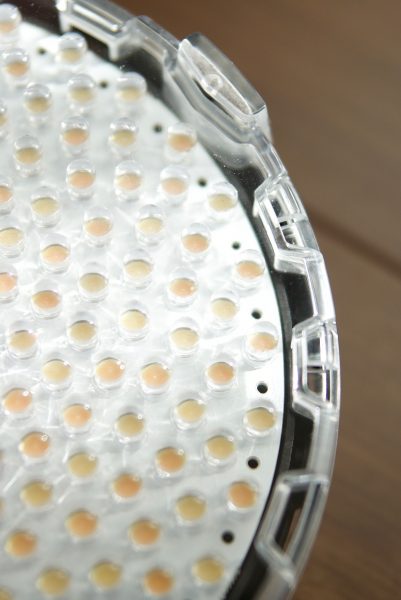
The NEO 2 weighs exactly the same as the original NEO, 354g (12.48oz). Just like the NEO, the NEO 2 is manufactured at Pinewood Studios in the UK and the overall build quality of the kit is pretty good. While the lights are made of a hard plastic material, they don’t feel cheap. All the buttons and latches feel fairly secure, and the included accessories are all well made.
Increased power
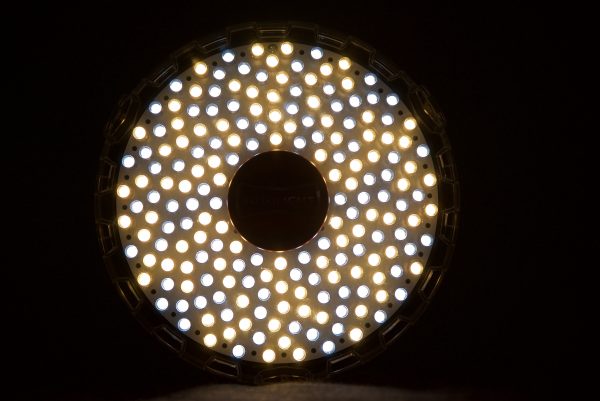
Small, compact lighting sources are great when it comes to portability, but the downside of this small size and weight is when it comes to output. Rotolight listened to complaints about the NEO’s power output, and the NEO 2 now has a claimed 85% increase over its predecessor. It’s hard to dramatically increase the output of any light without either increasing its size and/or power draw. So what have Rotolight done?
The size of the NEO 2 hasn’t increased, but the number of LEDs has.
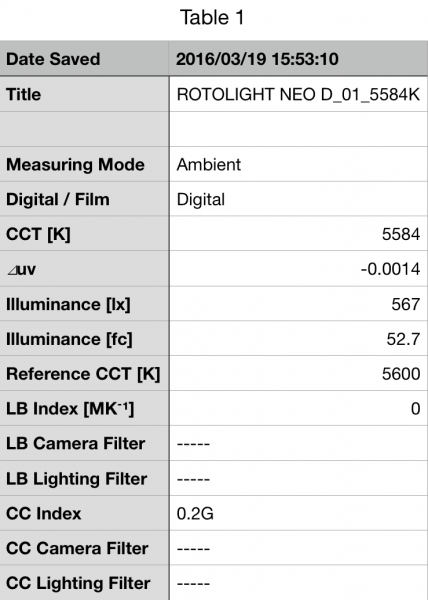
Above you can see that when I originally tested the NEO, it outputted 567lx at a distance of 1m (3.28ft) when set at 5600K. It also recorded a kelvin colour temperature of 5584K.
To see if the NEO 2 met the claimed 85% increase in power output I measure the light with a Sekonic C-700.
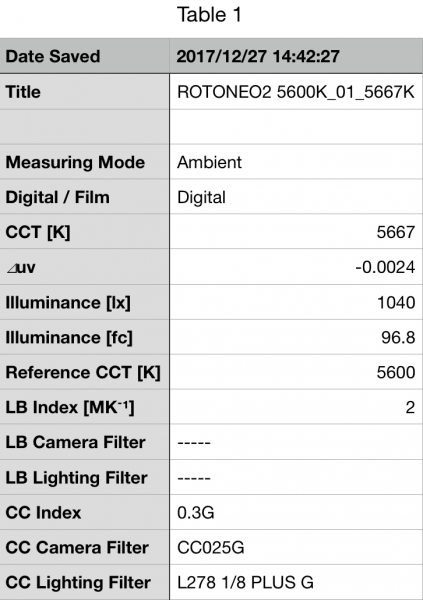
Above you can see that the NEO 2 when set at 5600K, produced an output of 1040lx at a distance of 1m (3.28ft). It also recorded a kelvin colour temperature 5667K. The output of 1040lx was a significant increase over the 567lx of the original NEO, and Rotolight’s claim of an 85% increase in output was confirmed.
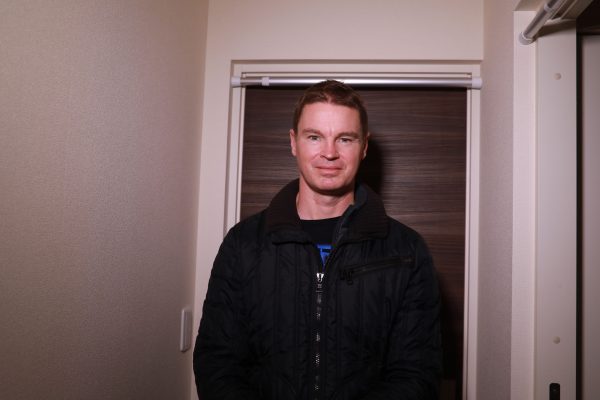
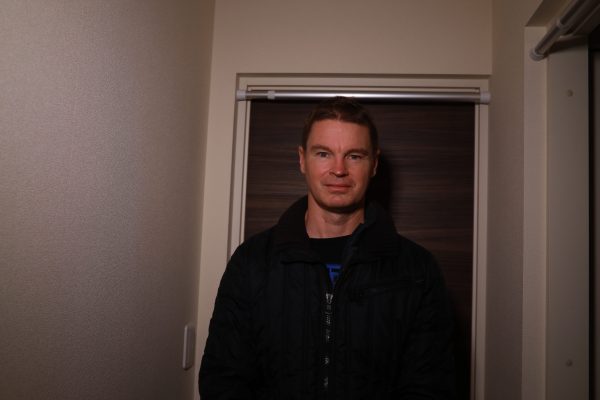
Above you can see a real-world comparison of the output differences between the original NEO and the NEO 2. The camera was set at 800ISO, f5.6 and 1/60 shutter for both shots.
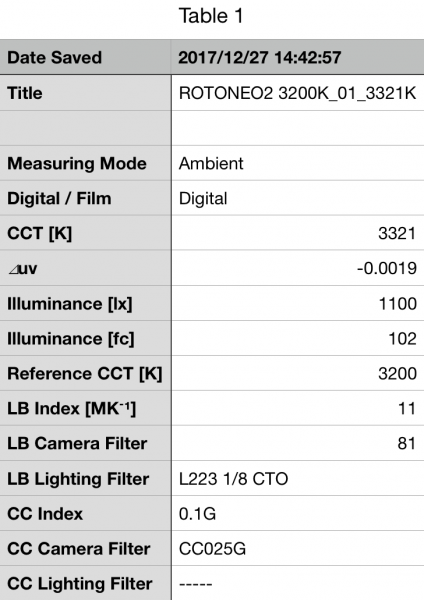
Above you can see that the NEO 2, when set at 3200K produces an output of 1100lx at a distance of 1m (3.28ft). In comparison, the original NEO has an output of 587lx at 3200K. It was good to see that the output was almost identical at 3200K as it was at 5600K. As far as accurately reproducing a 3200K source, the NEO 2 recorded 3321K.
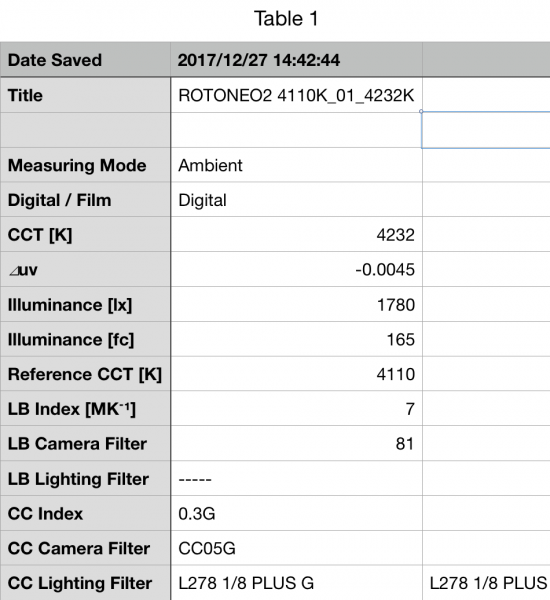
The original NEO and the NEO 2 both produce their maximum amount of output when set at 4300K and 4110K respectively. While this may seem like a strange kelvin colour temperature, it’s the point where the most amount of LEDs are illuminated on the fixture. Above you can see that the NEO 2 produced 1780lx when set at 4110K. This was a fairly hefty increase over the 1040lx it produced at 5600K. 1780lx from a light this size that can be run off AA batteries is very impressive.
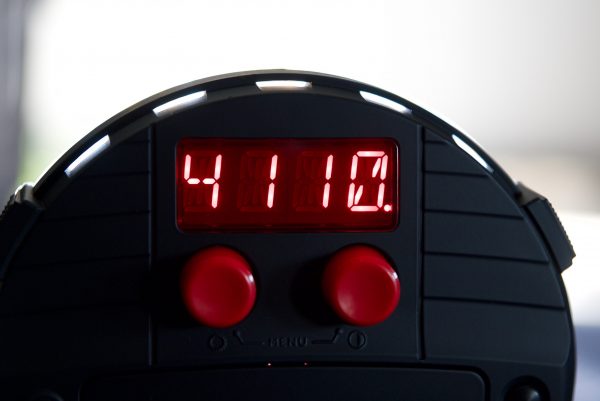
The LED display on the back of the light has a nice little feature that puts a little dot next to the kelvin colour temperature indicator that shows you where it produces its maximum amount of output.
The output increase is definitely a welcome addition, and just like the original NEO, the output stays fairly consistent at both 3200 and 5600K. Below you can see a performance graph (supplied by Rotolight) that shows the NEO 2’s output compared to some of its competition. I do however find this graph a bit misleading as it fails to mention at what kelvin colour temperature these readings were taken at.
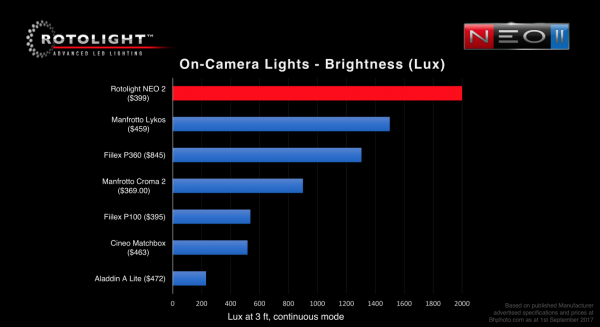
HSS flash
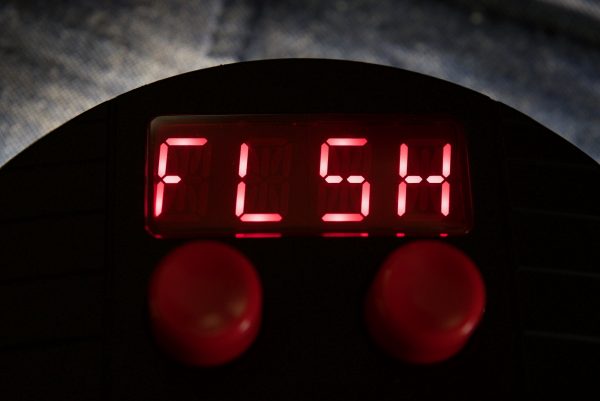
So what is HSS flash? High Speed Sync works by continuously pulsing the flash at very high speeds creating a stroboscopic effect that illuminates the shutter slit as it moves down the sensor. As HSS outputs so many pulses (flashes of light), it creates the illusion of having a continuous light source. The draw back of HSS is that the actual light output from the flash is fairly low and the output changes depending on the shutter speed. By using HSS you can create a consistent lighting source on your subject, but the flash (or in our case the NEO 2) needs to be fairly close to your subject.
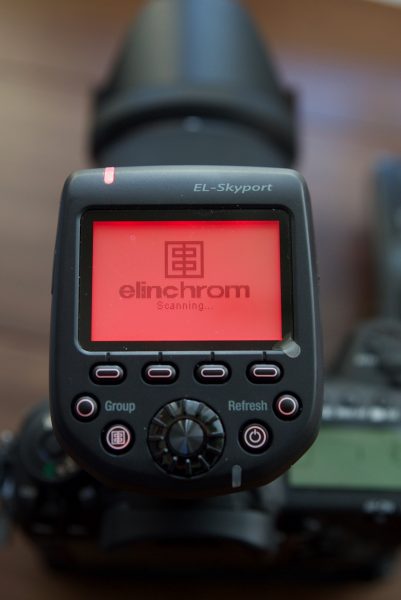
So how does the NEO 2 use HSS? Rotolight has an Elinchrom Skyport chip built right into the fixture. This 2.4 GHz Elinchrom Skyport Receiver makes it possible to use the NEO 2 as a remote flash with high-speed sync support up to 1/8000 second. The NEO 2 can be controlled by an optional Elinchrom remote, to wirelessly trigger the SFX on up to 10 lights in 4 groups at the same time. Rotolight claim this can be done up to 656′ (200m) away. You can also use any other flash trigger with a PC sync port, but you won’t be able to control the power output remotely.
Above you can see a useful video showing you how to set up the NEO 2 to work with an Elinchrom transmitter.
The problem with using traditional flash photography is the recycle time. Photography strobes can only keep firing for a certain amount of time before they need to re-charge up to be used again. The NEO 2 has no such problem as it doesn’t need any recycle time so it can keep firing the flash continuously. When running on batteries, Rotolight claim the NEO 2 can run for 85,000 full-power flashes. I didn’t have the time to fire off the flash 85,000 times, so I’ll have to take their word for it. 85,000 does sound like a lot considering a typical Speedlight can only get around 300-400 flashes on four AA batteries, but you do have to remember that LED bulbs are 96% more efficient than most traditional tungsten/xenon bulbs.
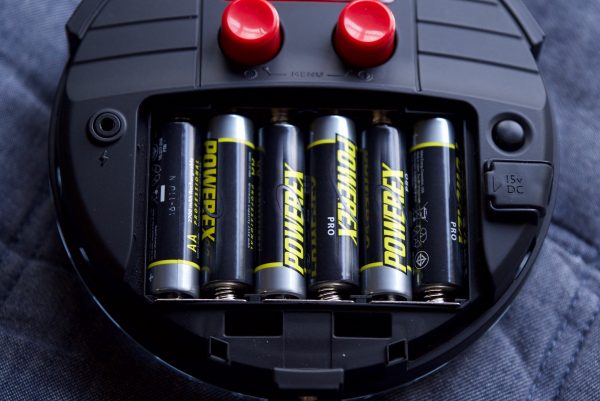
Rotolight claims that the NEO 2 provides around 500% more light output when connected to a mains power source, or 250% when running off AA batteries.
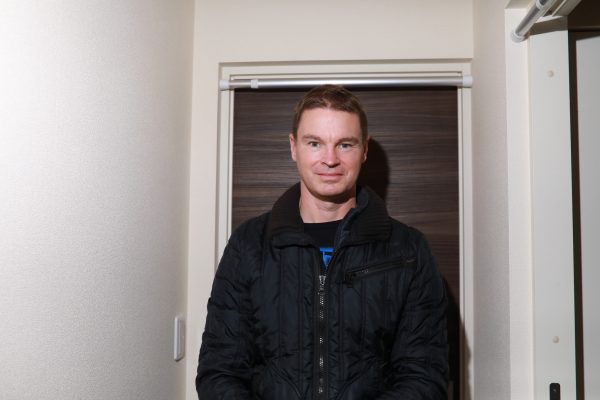
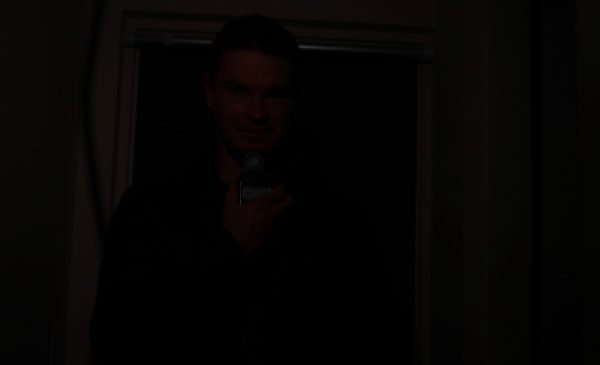
If you are a dedicated photographer then in certain situations the NEO 2 will struggle to be a substitute for a speedlight. In the bright un-diffused sun, it won’t have anywhere near the power of a speedlight and you won’t be able to get the same sort of results. Above you can see a comparison when a speedlight was set at 100% power. To obtain correct exposure the camera was set at f5.6 1/8000th shutter at 800 ISO. When we tried the NEO at these same settings you could barely even get an image.
If you are a dedicated professional photographer it can be used is as an additional creative tool along with your regular speedlight. It’s not that it can’t be uses as a speedlight replacement, but it does really depend on what you are shooting. If you are indoors then it can defiantly work for a lot of situations.
To be fair to Rotolight I don’t think they are marketing this light at professional photographers. The NEO 2 is primarily a LED fixture aimed at video shooters, with the added benefit of being able to be used for photography by someone who may be required to do both. It’s not pretending to be a speedlight replacement, but it certainly is a nice feature to have if you are someone working multimediadia.
Colour Rendering and Spectral Distribution
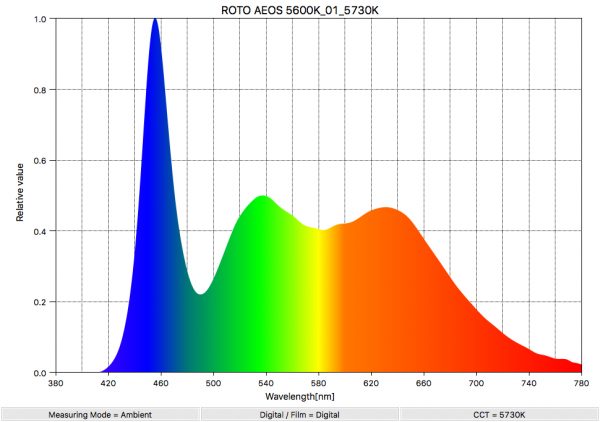
The original NEO had an average CRI (R1-R8) of 93.6 when set at 5600K, and an extended CRI (R1-R15) of 90.02. Above you can the spectral distribution of the original NEO. As you can see it has quite a lot of gaps in the spectrum, but surprisingly when I tested the light it still managed to look good on camera.
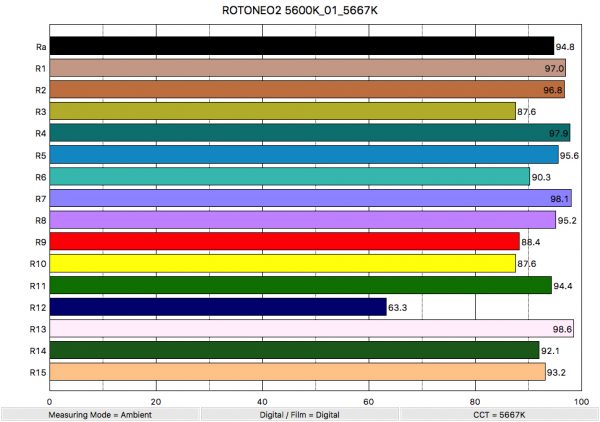
Above you can see the colour rendering scores for the NEO 2 when it was set at 5600K. The light had an average CRI (R1-R8) of 94.8 and an extended CRI (R1-R15) of 91.74. These numbers were a slight improvement over the original NEO.
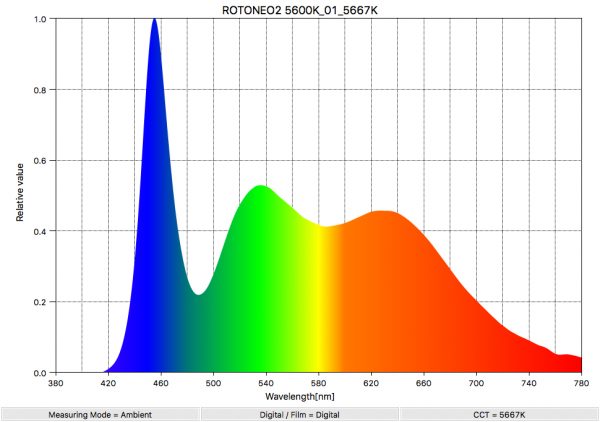
Above you can see the spectral distribution of the NEO 2. It is almost identical to that of the original NEO. Again there are plenty of gaps in the spectrum and a small green spike.
As a comparison below you can see the colour rendering and spectral distribution of the Cineo Matchbox when it was tested at 5600K. I have used this as a comparison as Rotolight compares the Matchbox in some of their published performance graphs.
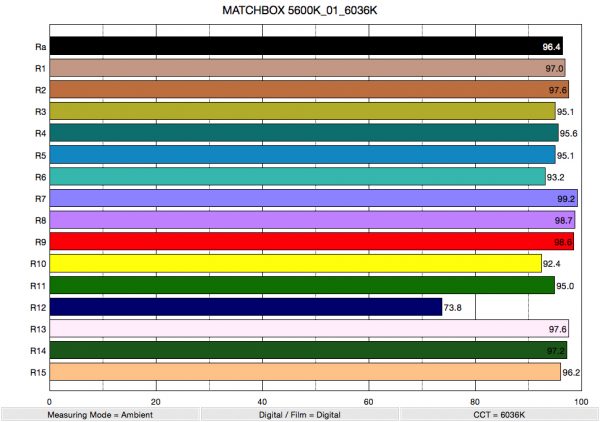
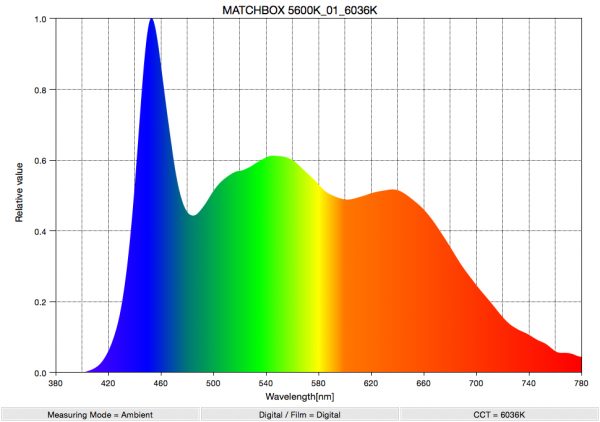
At you can see the Matchbox has a much better colour rendering scores and a more even and full spectral distribution of colour. It is important to note that this isn’t a colour adjustable fixture and you need to swap out phosphor panels to change the light between 5600K and 3200K. It also only outputs 346lx at a distance of 1m when tested at 5600K, as opposed to the NEO 2 which outputs 1040lx at the same kelvin colour temperature.
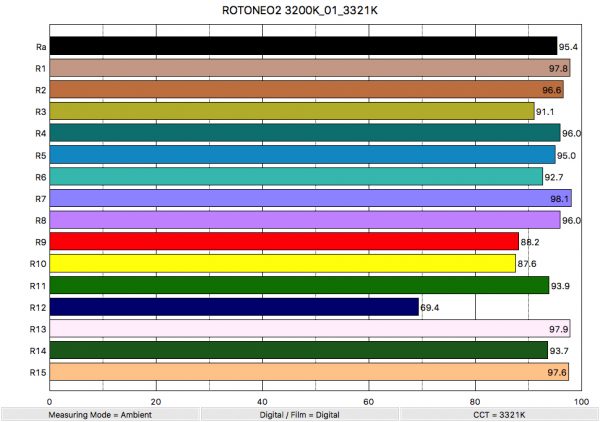
So we have seen how the NEO 2 performs at 5600K, what about at 3200K? Above you can see that the light recorded an average CRI (R1-R8) of 95.4 and an extended CRI (R1-R15) of 92.77.
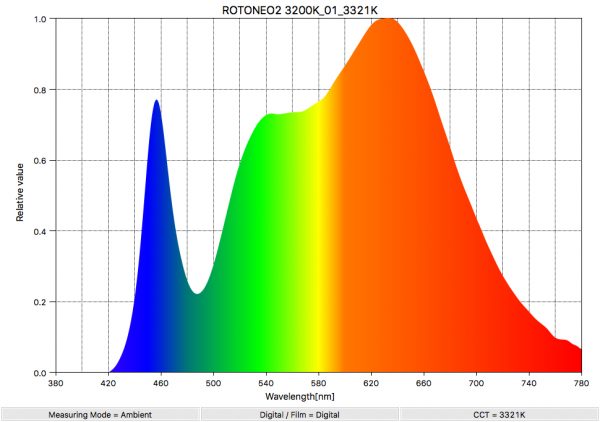
Above you can see the spectral distribution of the light at 3200K. The light does have a spike towards green. Below as a reference you can see how it differs from the Cineo Matchbox when it is used at 3200K. You can see that the Cineo has a more rich amount of colour throughout the spectrum and no real spikes.
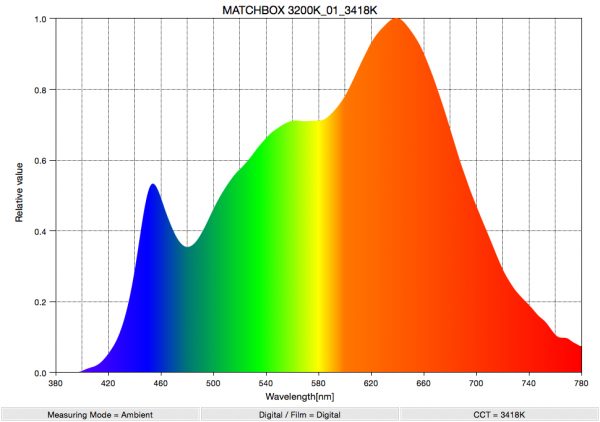
True Aperture Dimming
Just like the original NEO, the NEO 2 also has the True Aperture Dimming function. This allows the light to show a fairly accurate brightness setting calculated as an F-stop. Above you can a see a video illustrating how it works using the original NEO. To use True Aperture Dimming, all you need to do is dial in the distance your light to from your subject, and what ISO you are running on your camera. The light then calculates the f-stop using an algorithm based on the NEO’s brightness, the ISO and the shutter speed. This enables you to set your lenses f-stop value accordingly. Alternatively you can dial in the lens f-stop value and ISO and the light will tell you how close or far away it needs to be from your subject. This is a very clever feature and from my above test you can see that the results are very accurate indeed. It can save you a lot of time when setting up your lights.
CineSFX
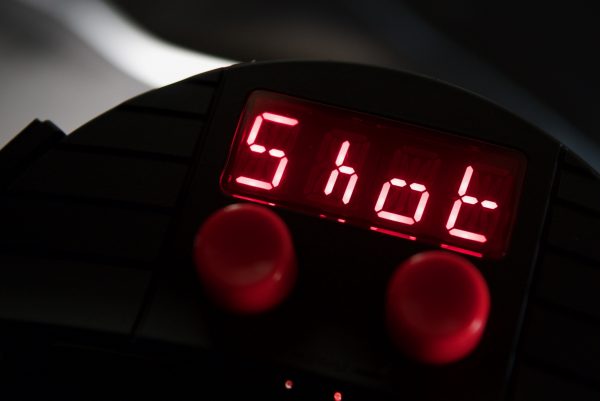
Again just like original NEO, the NEO 2 has a set of CineSFX built into the fixture. These effects have been designed to add production flair to music videos and films. These are not something most factual shooters are likely to use very often, but it is still impressive to see a light of this price have these capabilities.
The original NEO featured a strobe feature, lightning, throb, colour cycle, fireblue, mono, Police and Television effects. The NEO 2 has all of these plus gunshot, paparazzi, neon flickering light, and many more.
What’s great is that you can now trigger these effects using the optional Elinchrom remote or any other flash trigger with a PC sync port. This functionality gives you a lot of creative freedom and by triggering the flash you can pulse effects at anytime. This is great if you are for example shooting a music video and want to have complete control over your effects. The ability to trigger up to 10 lights in 4 groups at the same time is great if you have multiple Rotolight fixtures. If you had say a couple of Anova Pros and a few NEO 2s you could trigger them all in perfect sync.
Above you can see a short video showing how you can use the NEO 2 lights to create some interesting lighting effects when shooting video. My friend Taro Irei used three of the NEO 2 fixtures with the 5D mark IV. Taro also used one red and one blue filter with the lights to create the colour he needed. The video was shot 1080 60p,1600 ISO in Canon Log.
Above you can see how he was doing it. Using the flash function, he was able to shoot stills, while controlling the power output from the elinchrom remote. And with the same set of lights, switching to the FX mode he shot video with the same lights and set up. All within 15min. Here is a couple of the stills taken below.
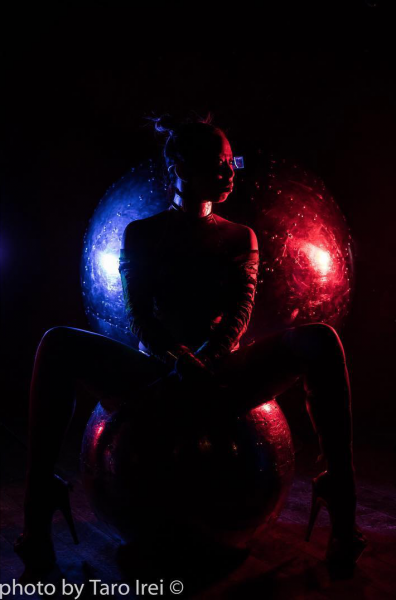
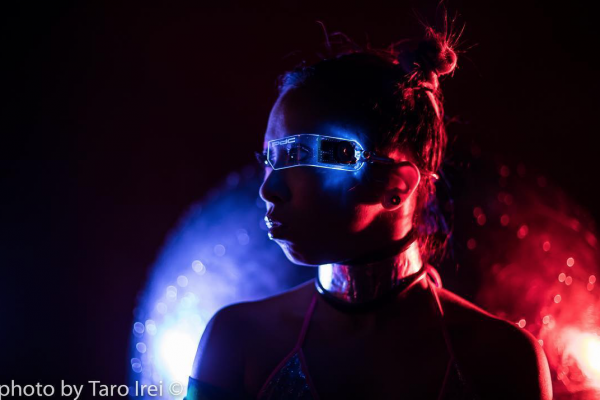
What does the quality of the light look like?
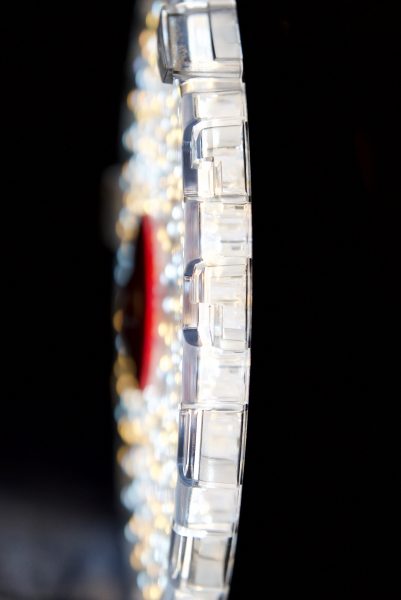
It’s no real surprise that the NEO 2 looks almost identical to the original NEO. It is good to see that Rotolight has been able to maintain the quality of the light while also dramatically increasing the brightness. While there are some other lights in this class that are more colour accurate, there aren’t many, if any, that can produce the same amount of output.
This increased output makes the light a lot more versatile than the original NEO and allows it to be used as a key light for an interview as long as you don’t have it too far away from your subject. This is something you really couldn’t do with the original NEO.
Rotolight have always made lights that despite what the facts and figures may say, produce nice results. Just like the Anova Pro and the AEOS, the NEO 2 looks a lot better than its scores may imply.
Price
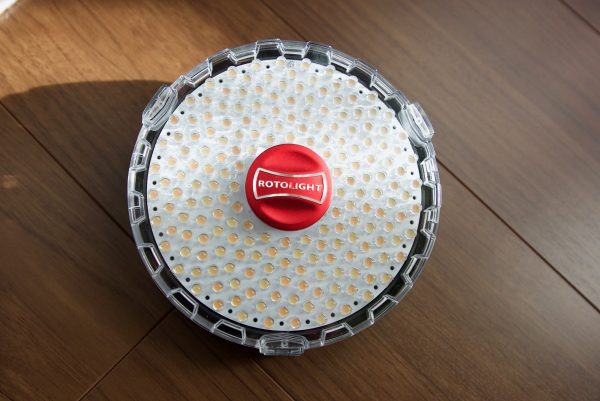
The NEO 2 retails for $399 USD and for that you get:
- Rotolight NEO 2 LED Light
- Filter Pack
- Filter Holder
- Shoe Adapter to 1/4″ Male Stud
- RL-NEO-PSU AC Adapter for NEO LED Light
- Belt Pouch Carry Case
- Limited 1-Year Warranty
Hidden costs
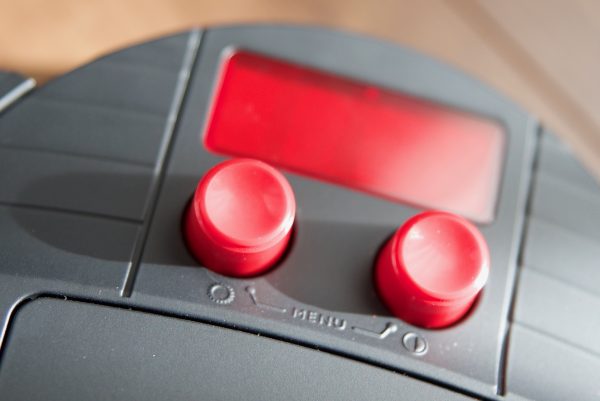
While the $399 USD price tag offers good value for money you do need to be aware of the hidden costs. If you want to take advantage of the HSS function you will need to fork out an additional $249.95 US for an Elinchrom flash trigger. You also need to keep in mind that these are specific to certain DSLR/mirrorless cameras and for example the one that works on a Canon camera won’t work on a Nikon camera.
Barn doors are an extra $129.99 USD, and if you wan’t to shape the light you really do need one. A softbox for the Neo 2 is also $129.99 USD.
3-Light Kit
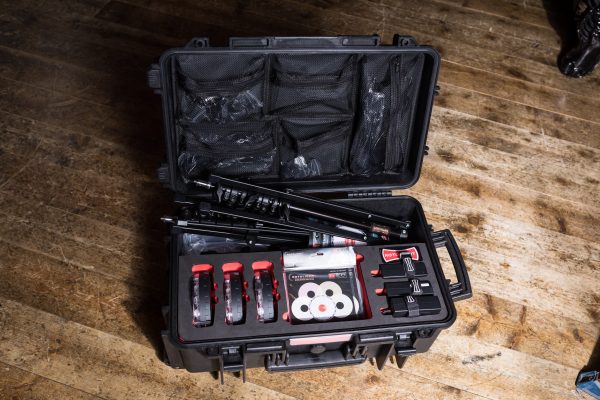
The NEO 2 can be bought separately or in a nice 3-light kit that comes in a nice custom laser cut hard case. The 3-light lit certainly offers good value for money as for $1,599.99 USD you get:
- 3x Rotolight NEO 2 LED Lights
- 3x RL-Compact-LS Light Stands
- 3x RL48-360-PRO Ball Heads
- Add-On Color FX Pack
- Hard Roller Case
- 3x Hot-Shoe Mount Adapter
- 3x Rotolight Universal Power Adapter
- 3x Gel Filter Holder
- 3x 4-Piece Filter Kit (#216 White Diffuser & #250 Half White Diffuser & #184 Cosmetic ‘Cosmetic Peach’ & #279 1/8 Minus Green ‘Magenta’)
- Accessory Belt Pouch
- Rotolight 1 Year Warranty
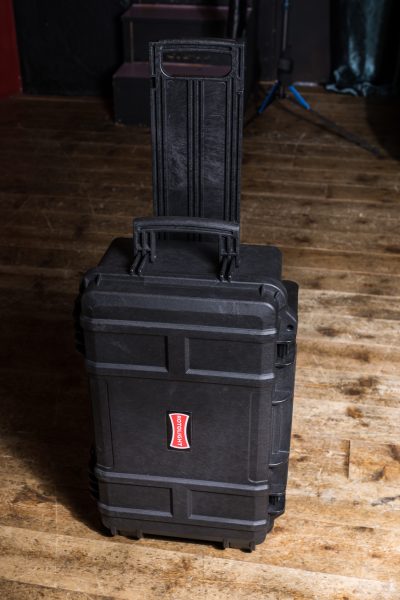
Rotolight have managed to reduce the overall weight of the 3-Light kit case by 30%. While the hard case is really well made and solid, it does make the 3-light kit heavy. I personally would have preferred to have seen another version come in a smaller, soft case. The NEO 2 fixtures are so small and lightweight that I find it counter intuitive to put them in a heavy case. The other problem with the hard case is the wheels aren’t great. I found if I tried to wheel the case over uneven ground that small items like pebbles and sticks often got stuck in-between the wheels and the case.
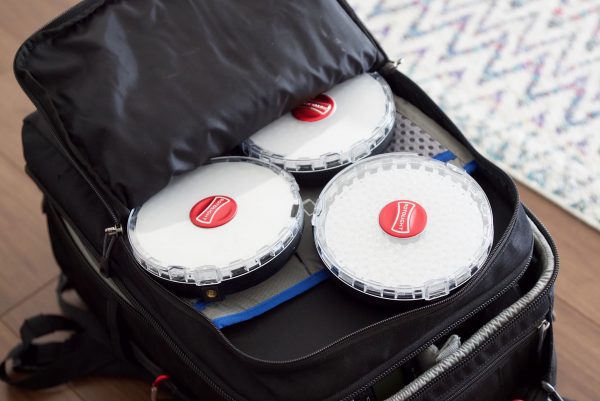
I much prefer to put them in a backpack or smaller bag as one of the main reasons I would want to use small and compact lights is to save on weight and space.
Competition
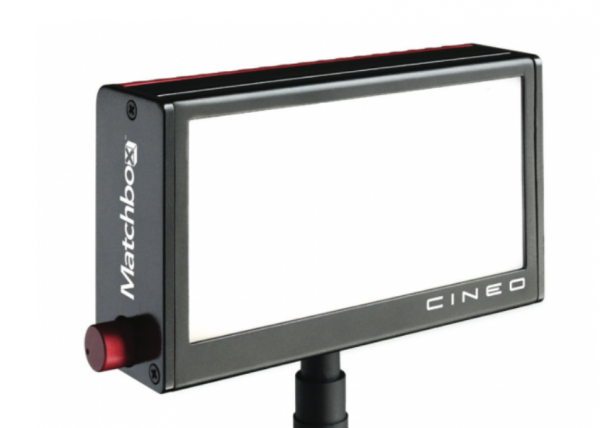
There are a lot of options when it comes to small, compact LED lighting fixtures that can bought separately or in kits. Rotolight see their main competition as the Manfrotto Lykos, FiiLex P360, Manfrotto Croma 2, Fiilex P101, Cineo Matchbox and Aladdin A Lite, but I think the Litepanels Caliber are also direct competition. As far as price goes here is a list of how they all compare:
Rotolight NEO 2 $399 USD
Rotolight NEO 2 LED Light
Filter Pack
Filter Holder
Shoe Adapter to 1/4″ Male Stud
RL-NEO-PSU AC Adapter for NEO LED Light
Belt Pouch Carry Case
Limited 1-Year Warranty
Manfrotto Lykos Bi-Colour $489.25 USD
Manfrotto LYKOS Bi-Color On-Camera LED Light
AC Adapter
Diffusion Gel
Limited 1-Year Warranty
FiiLex P360 $395 USD
Fiilex P360 LED Light
Set 4-Way Barndoors
AC Adapter
DC Adapter
Instruction Manual
Limited 2-Year Warranty
Manfrotto Croma 2 $333.09 USD
Manfrotto CROMA2 LED Light
Ball Head
Gel Diffuser
AC Adapter
L-Type Battery Adapter
Limited 2-Year Warranty
Fiilex P101 $395 USD
Fiilex – P101 Battery-Powered LED Light
Rechargeable Battery
Cold Shoe with Mini Ball Head
AC/DC Power Adapter (Wall Charger)
Limited 1-Year Warranty
Cineo Matchbox $245 USD
Cineo Lighting Basic Matchbox LED Light Kit
3200K Phosphor Panel
5600K Phosphor Panel
120-240 VAC Adapter
6′ Power Extension Cable
Limited 2-Year Warranty
Aladdin A Lite $449.10 USD
Aladdin A-LITE Bi-Color Dimmable Light Fixture (3000 to 6000K)
Micro-USB Cable
Diffusion
Limited 1-Year Warranty
Litepanels Caliber $329 USD
Caliber LED Fresnel
Manfrotto Pixi
Gel Frame
Gel Set (1/2 CTO & 1/2 CTB)
4-way Barndoors
AC Adapter with International Plug Set.
As you can buy the Rotolight NEO 2 in a 3-light kit, here are just a few of the other similar options that are available:
Litepanels Caliber 3-Light Kit $995 USD
3x Caliber Fresnels Fixtures
3x Manfrotto Pixi
3x Gel Sets
3x Color Frames
3x 4-Way Barndoors
1x Compact Light Stand
1x Stand Adapter
1x Ball Head Shoe Mount
3x International Power Supplies
1x Soft Case with Customizable Interior Compartments
Fiilex 301 3-Light P360 LED Kit $1495 USD
3 x P360 LED Light
Set 4-Way Barndoors
AC Adapter
DC Adapter
Instruction Manual
Limited 2-Year Warranty
Aputure LS-mini20 3-Light Flight Kit with Stands $719 USD
2 x LS-mini20d LED Heads
LS-mini20d Bi-Color LED Head
3 x 4-Way Barndoors
3 x AC Power Supplies
3 x Power Cables
3 x NP-F970 Batteries
3 x Battery Adapters
3 x Battery Chargers
3 x Universal Cold Shoe Mounts
3 x Crab Clamps
3 x D-Tap to XLR Cables
3 x USB Type-A to XLR Cables
3 x Filters (5500K)
3 x Filters (3200K)
3 x Light Stands
Stand Case
Limited 1-Year Warranty
Litepanels Lykos Bi-Color Flight Kit with Battery Bundle $2370.25 USD
3 x LYKOS Bi-Color On-Camera LED Light
AC Adapter
Diffusion Gel
Limited 1-Year Warranty
3 x 5001B Nano Black Light Stand – 6.2′ (1.9m)
3/8 (Euro) to 1/4-20″ Male
Limited 1-Year Warranty
3 x NP-F976 7.2V, 6600mAh L-Series Li-Ion Battery (47Wh)
Limited 1-Year Warranty or 500 Cycles
3 x Single Charger with US Plug for L-Series Batteries
Limited 1-Year Warranty
Conclusion
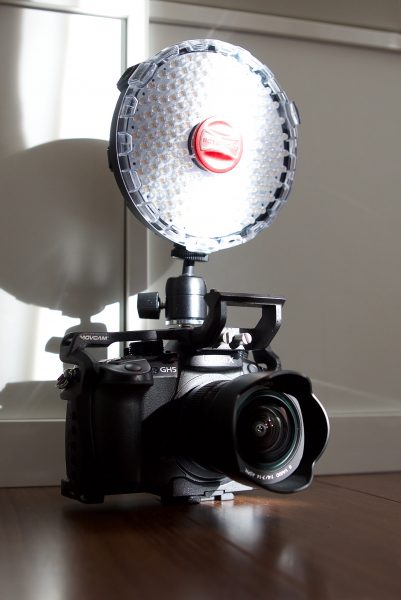
The NEO 2 is certainly a feature packed light that offers a lot of bang for your buck. With increased output and a host of features that none of its competitors can offer, it certainly stands out in this category. The fact that this light can be run off AA batteries and produce as much output as it does is a real testiment to Rotolight’s engineering and development team. Rotolight seem to be right at the top of the pyramid when it comes to creating power efficient LED fixtures.
Small, compact fixtures like this can’t be used for every lighting situation, but Rotolight have managed to squeeze as much versatility and functionality out of the NEO 2 as possible. For people working in multimedia where you are required to take both video and stills the NEO 2 is a very compelling light. The 3-Light kit makes a lot of sense if you are looking for a compact all-in-one lighting solution. If it was me, I’d probably not use the hard case as it makes a lightweight kit not so lightweight.
All in all Rotolight have done a good job with the NEO 2 and it certainly is worth looking very closely at if you are after a small, lightweight, colour adjustable, and power friendly lighting fixture.



